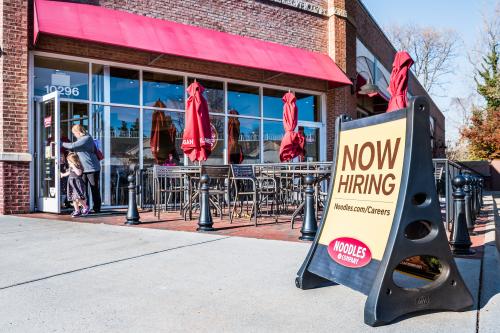Labor markets in the US are currently tight, and are generating substantial growth in nominal wages – i.e., those measured in current dollars (not adjusted for inflation). On the other hand, wage growth does not appear to be keeping up with inflation right now, regardless of how the latter is measured.
Whether market tightness will last, and whether workers can expect to enjoy some real (or inflation-adjusted) wage growth anytime soon, is very hard to predict. Still, some facts about our currently tight labor markets, and the wage growth they have or have not generated, can give us insights into how economic policymakers should respond to current circumstances, including high inflation. If possible, we want to help generate more real wage growth for workers – especially for those in low-wage jobs and industries, whose real wages have been mostly stagnant for decades (Groshen and Holzer, 2021).
Here are what I think are the most important facts on the currently tight job market and recent wage growth.
1. Until recently, nominal wages have more than kept pace with inflation, allowing real wages to grow since the start of the pandemic.
Figure 1 indicates that workers enjoyed over 2 percent real wage growth in 2020-21, even after adjusting for the fact that the composition of the workforce changed in that time period.1 Unfortunately, inflation has been higher than wage growth since mid-2021; but, if supply-side price shocks soon diminish, real wage growth could return (as long as such growth itself doesn’t generate too much inflation).
2. Nominal and real wage growth have been highest in the lowest-wage sectors of the economy.
Figure 2 indicates that nominal wages increased the most among leisure/hospitality and retail workers – the two lowest-wage sectors of the US economy – and especially among non-supervisory workers. Using virtually any price index to adjust for inflation over these two years, workers in these sectors experienced real wage growth.2
3. High job vacancy and quit rates in leisure/hospitality and retail have apparently generated the stronger wage growth we observe in these sectors.
Figure 3 shows that, while overall job vacancy rates in the US economy are 7%, those in retail and leisure/hospitality are 8-10%. Alex Domash and Larry Summers (2022) recently show that vacancy and quit rates are the strongest predictors of wage growth, and comparisons across sectors support that view. It is also clear that the rise in quit rates, overall and within these sectors, can account for some, though not all, of the rise in job vacancy rates between 2020 and 2022; this indicates that vacancies are more frequent but also last longer than before, as workers appear less likely to accept the wage offers that they receive.3
4. Declining labor force participation now accounts for almost all of the “missing employment” (relative to the pre-pandemic labor market) in the US today.
Using monthly BLS employment data, the decline in labor force participation between February 2020 and 2022 accounts for about 85 percent of the decline in the employment/population ratio in that period; the rest is accounted for by unemployment, which can reflect both labor demand-side (employer) and supply-side (worker) factors.4 This reinforces the view that it is aggregate labor supply that mostly constrains employment growth now, more than absent labor demand, and the supply constraints raise job vacancy rates as well.5
5. Productivity growth has likely helped generate some of the real wage growth we have observed, and might play an even greater role going forward.
Productivity growth appears to be a major source of real wage growth over time, even though the relationship between the two has weakened somewhat over time (Stansbury and Summers, 2017). And measured productivity growth has averaged over 2 percent per year since the pandemic, which – if everyone’s share of output had remained stable, might have generated 4 percent real wage growth. Unfortunately, supply-side price shocks have likely diminished labor’s share of output. On the other hand, if such shocks diminish; and if we are at what some economists call a “Solow moment” – when the economic benefits of automation, in terms of higher productivity, are soon likely to become clearer- real wage growth might reappear.6
6. Education and training could also help ensure that workers benefit from productivity growth, in the form of real wage growth, going forward.
Vacancy rates and wage growth in professional services and health care have also been substantial, and indicate strong demand in these sectors for workers with postsecondary education and training.7 In addition, the new infrastructure bill (and Baby Boomer retirements) will likely create more labor demand in construction and manufacturing, which could be filled by well-targeted training programs for these sectors.8 Of course, broad-based growth in educational attainment among workers can also enhance productivity growth over time.
Discussion
If supply-shock price inflation diminishes soon – despite the Ukraine War, and even if prices level off at a high level – there might still be sufficient labor market tightness to generate real wage growth. Of course, this also assumes that the Fed’s new policy of interest rate growth can succeed without causing a “hard landing,” in the form of a (potentially serious) recession. And wage growth itself must not be a major cause of inflation.
Large nominal wage increases currently reflect tight labor markets (plus productivity growth), generated by the following:
- Declining labor force participation, primarily among older workers (ages 55+) who had left the workforce (though many are now returning) and women who have provided the care needed for other family members;
- Increases in quits – especially in low-wage jobs – as workers are more dissatisfied with conditions in their earlier jobs; and
- Increases in what economists call workers’ reservation wages – the lowest wages they will accept on new jobs – which extend their job searches and add to job vacancy rates.
The greater dissatisfaction that workers now seem to feel in low-wage jobs is not a bad way to pressure employers to improve wages and working conditions – especially if it lasts.9 And some falling labor force participation among older workers, even if temporary, was perhaps inevitable – given the rise in their asset values in recent years. But falling participation among prime-age workers and especially women could be counteracted with family-friendly policies, like more child-care and paid leave.
And, though declining labor force participation likely adds to the market tightness that raises wages, it comes with significant costs. First, nonparticipation impedes employment and earnings that these potential workers would otherwise enjoy; second, it likely contributes to price inflation, especially by generating worker bottlenecks in key industries (like those in transportation and logistics); and third, it also reduces tax revenues that could finance needed services.
Our best hope of achieving higher real wages while reducing inflation and encouraging employment would be to increase labor force participation (with family friendly policies) and education/training to improve worker productivity and wages over time. To train workers in the short term for new jobs in sectors like construction, manufacturing or health care, we should expand sector-based training programs for those sectors. Indeed, recent evidence (Holzer, 2022) suggests that such training can be very effective in raising worker earnings. And providing workers with better information about job openings and wages, to help them move to high-demand/high-wage sectors, can be very useful in increasing their wages as well.
References
Albanesi, Stefania and Jiyeon Kim, 2021. “Effects of the Covid-19 Recession on the US Labor Market: Occupation, Family and Gender.” Journal of Economic Perspectives, Vol. 35, No. 3.
Domash, Alex and Lawrence Summers. 2022 “How Tight are US Labor Markets?” National Bureau of Economic Research Working Paper No. 29739.
Deloitte, 2021. “US Manufacturing Skills Gap Could Leave as Many as 2.1 Manufacturing Jobs Unfilled by 2030, a Study by DeLoitte and the Manufacturing Institute finds.”
Groshen, Erica and Harry Holzer. 2021. “Labor Market Trends and Outcomes: What Has Changed Since the Great Recession? Annals of the Academy of Political and Social Science. Vol. 695, No. 1.
Hershbein, Brad and Harry Holzer. 2021. “The Covid-19 Pandemic’s Evolving Impact on the Labor Market: Who Has Been Hurt and What Should We Do.” IZA Discussion Paper.
Holzer, Harry. 2022. Do Sectoral Training Programs Work? What the Evidence on Project Quest and Year Up Really Shows. Policy Brief, Economic Studies, Brookings Institution.
Howard, Sean et al. 2022. “Real Wages Grew During Two Years of Covid-19 After Controlling for Workforce Composition.” Federal Reserve Bank of Dallas.
Sheffield, Liz 2019. “Construction Grows, But Baby Boomers Retiring Leaves Gap.” ADP.
Stansbury, Anna and Lawrence Summers. 2017. Productivity and Pay: Is the Link Broken? National Bureau of Economic Research Working Paper No. 24165.
The Brookings Institution is financed through the support of a diverse array of foundations, corporations, governments, individuals, as well as an endowment. A list of donors can be found in our annual reports published online here. The findings, interpretations, and conclusions in this report are solely those of its author(s) and are not influenced by any donation.
-
Footnotes
- Howard et al. (2022) adjust for the fact that the pandemic recession reduced the share of low-wage workers in the job market in 2020, thereby biasing wage growth upwards, while increasing their share in 2021, thus biasing wage growth downwards. They use the CPI-W to adjust nominal wages for inflation.
- These data do not adjust for changes in the composition of the workforce, though that is a less relevant concern when considering within-sector wage changes. Inflation in this period was 10.7 percent using the CPI-W, 9.5 percent using the chained CPI for urban workers, and 7.6 percent using the PCE price index – so real wages grew in retail and leisure/hospitality between February 2020 and 2022 by any measure.
- The frequency of vacancies in any period reflects total separations plus the creation of vacant new jobs; vacancy durations reflects how long it takes employers to fill vacant jobs. Quits are higher but non-quit separations are lower now than two years ago. While many new jobs have been created in recent months, as the labor market continued its recovery from the Covid-19 recession, these plus quits likely do not fully account for the very large increases in vacancies observed in retail trade and leisure/hospitality – implying that vacancy durations have risen too.
- In other words, unemployment can be relatively high either because employers are creating too few jobs or because workers are not filling those jobs very quickly, perhaps because they feel the wages offered are too low.
- Approximately half of declining labor force activity reflects workers at ages 55 and older, who retired sooner than expected – though some could reenter the workforce as Covid health risks decline (or if their assets were to lose some of their accumulated value). As Table 4 indicates, labor force withdrawal among women has been larger than that among men. See Albanesi and Kim (2021) and Hershbein and Holzer (2021).
- BLS data indicate that total labor productivity rose approximately 2.4 percent in 2020 and 2.0 percent in 2021. Nobel Laureate economist Robert Solow famously wondered in the early 1990s why technical change was being observed “everywhere except in the productivity data”; the latter then rose dramatically just a few years later. Of course, most economists believe that measuring productivity growth accurately is quite difficult.
- Job vacancy rates in January 2022 were 8.6 and 8.8 percent in professional and health care services respectively, while nominal wage growth rates in 2020-22 were approximately 10 and 12 percent in these sectors.
- While vacancies in construction and manufacturing are not high right now, approximately 40 percent of all construction workers are expected to retire in the next decade (Sheffield, 2019) while manufacturers continue to have difficulty finding skilled technical workers (DeLoitte, 2021).
- Whether the higher reservation wages of workers can persist, even after their savings from the pandemic are exhausted, remains an open question.







